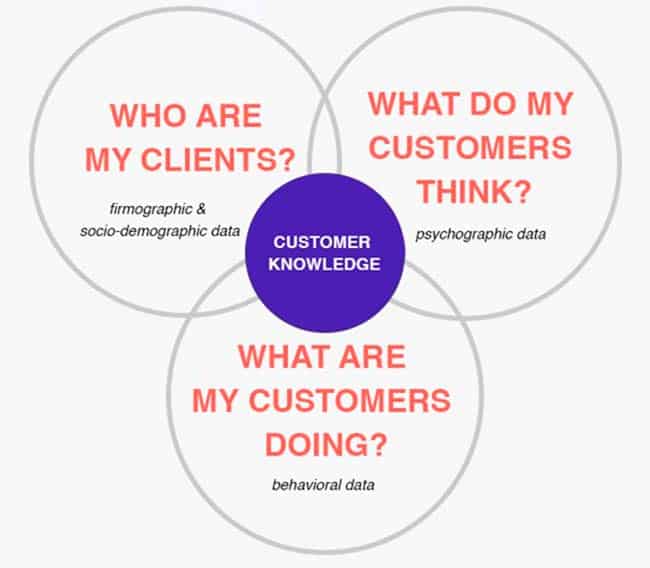You want to implement a system to collect more customer data. You understand how important customer data is to personalise your customer experience and communications. You’re don’t need convincing. But you’re looking for some advice about how to do it. Am I right?
If you’re reading this article, you’re probably in that very situation. Or maybe you’re simply interested in data collection. Either way, don’t blindly create surveys without doing some research first…
Before you even start collecting customer data, you need to answer these 4 questions. They’ll help you structure your approach and ensure its success.
1 – What Are Your Goals?
You want to collect customer data. That’s great! But why? Why have you decided to enrich your customer knowledge and collect more customer data? Data collection isn’t an end in itself, it’s a means to an end. This is even more true since the GDPR came into force, which requires companies to only collect data they really need.
Frame Your Objectives in a Workshop
Before defining the data to collect and before thinking about collection mechanisms, take the time to frame your objectives. This can take the form of a workshop during which you list, qualify, formulate and discuss your goals, before prioritising them. You can’t do everything at the same time. Which is why it’s so important to prioritise your marketing and CRM objectives. Ideally, this workshop should include representatives from each department that uses customer data. Starting, of course, with marketing.
2 – What Data Do You Need to Collect?
Once you’ve defined your objectives, you can identify the data that you need to achieve these goals.
Three Examples of Translating Objectives into Target Data
- First example. You’ve set an objective to improve customer satisfaction. To achieve this objective, you’ll need to measure customer satisfaction and therefore collect satisfaction data: Net Promoter Score, Customer Satisfaction Score, Customer Effort Score, etc.
- Second example. You’ve set an objective to personalise your special offers. You’ll need to collect data to find out more about your customers’ needs and expectations, as well as their interests and preferences. This data will then help you better target your communications.
- Third example. You want to improve your brand image and deploy an ambassador programme. You’ll need to collect satisfaction data to identify your best customers, your promoters. This is one of the use cases of the leading customer satisfaction indicator, the Net Promoter Score. NPS allows to identify a brand’s promoters.
From Objectives to Data and Actions
We could give you lots of examples, but it’s important to understand the logic. You may have noticed that between objectives and data are actions.
In other words, you’ve defined an objective. To achieve this objective, you need to implement an action: a customer relations programme, an operation, an ad campaign, a marketing automation scenario, etc.
To implement this action, you need certain customer data: socio-demographic data, psychographic data, or even behavioural data.

3 – How Can You Collect Customer Data?
You’ve now qualified your objectives and the actions to implement in order to achieve them. You’ve also qualified the data required to deploy these targeted actions. You’ve therefore answered the “why” and “how” questions. The next step is to think about “how”. You’re now ready to build your collection plan, to think about which mechanisms to use to collect the data you need. To imagine these collection mechanisms, you need to consider the following questions:
Who?
Which customers do you want to target? Are you looking to collect data from all your customers or a specific segment?
When? [At What Moment?]
What’s the best time on the customer journey to collect missing data? After a purchase? After an interaction with customer services? If you want to increase your chances of collecting target data, then choose your moment wisely.
Where?
In other words, which channel do you want to collect data on? On which device, which media? On your website? On social media? On your in-store or restaurant kiosk? At check-out? On your mobile app? By email? On the phone? Opt for the channels that your customers use the most.
With Which Tool?
There are several tools available to collect customer data. The most effective one is the customer survey. It’s also the most natural.

Indeed, the easiest way to collect information about a customer is to ask them directly in a survey. Creating surveys is a key part of any customer knowledge strategy. We’ve published lots of articles about the best practices to follow to create successful surveys.
4 – How Can You Use Data and Integrate it into Your Tools?
It’s important to anticipate from the start how this data will be used and integrated into your tools. You will collect data X with a collection tool. This data X won’t remain in the collection tool. The objective is to incorporate it into your data base or tool with which it will be used: CRM software, marketing automation solution, customer relationship management software…
Your collected data should be actionable. It therefore needs to made available to your teams and integrated into your tools. Before you start collecting data, you need to ensure that your data is accessible within your company’s information system. We recommend choosing a customer knowledge tool that will easily enable you to share the collected data in your company’s business tools. In other words, a tool with good connectivity and a good library of native connectors with the leading tools on the market.
These are the four key questions to ask when building an effective customer data collection system. We encourage you to think about them carefully. The success of your customer satisfaction strategy depends on it!



















